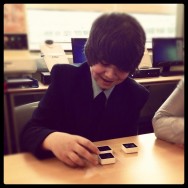 I have been waiting near on three years to get my hands on a set of Sifteo cubes. First I read about the concept behind, then I watched David Merill’s TEDtalk and then I waited. And waited a little longer for the release date only for my hopes were dashed when pre-orders were limited to US only, and now finally… we have a UK distributor, RM. Can you tell I am still very excited about this product? I am not the only one that is enthused, let me summarise the vibe so far: innovative, playful, tethered (limited mobility), simple graphics, huge potential.
I have been waiting near on three years to get my hands on a set of Sifteo cubes. First I read about the concept behind, then I watched David Merill’s TEDtalk and then I waited. And waited a little longer for the release date only for my hopes were dashed when pre-orders were limited to US only, and now finally… we have a UK distributor, RM. Can you tell I am still very excited about this product? I am not the only one that is enthused, let me summarise the vibe so far: innovative, playful, tethered (limited mobility), simple graphics, huge potential.
This post is not a product review, there are enough of those in circulation already, rather it considers how Sifteo cubes can engage and move learners on and has been made possible with the generous support of Rose Taylor at RM.
What makes Sifteo cubes unique?
Siftables aims to enable people to interact with information and media in physical, natural ways that approach interactions with physical objects in our everyday lives.
IMHO the team behind the Sifteo cubees are definitely succeeding.
There are plenty of obvious learning opportunities, and many more of the way. More game titles and the simple creativity kit enables you to design bespoke learning tasks. Certainly, the list of learning skills promoted by the Sifteo cubes reflects the growing game titles and many of these skills can be developed through game play elsewhere. Strategy, spatial, creative, language, literacy, numeracy, social, problem solving, sorting and classifications are all available online, as apps and as board games. Yet I think that there is a place for the Sifteo cubes, there’s a distinctly physical aspect of Sifteo games that’s missed with touch screen games, and there is also the ‘beyond screen’ and abstract aspects of Sifteo games that are explored by games such as ‘Gopher Run,’ that our students seemed to really enjoy.
A second area that we aim to explore is how the matching and movement skills promoted by the neighbouring and tilting activities and to a lesser extent the standing and flipping activities may support and accelerate ‘learning potential’ in other areas. By that we mean, by activating the movement control areas of the brain, we hope to stimulate the ‘learning’ areas of brain used for common classroom tasks. A conversation we hope to explore with our schools SEN consultant.
Finally, we used the kit to create a series of simple sequencing questions to remind / assess my Year 7 class new what five components were required in a good story. In case you didn’t already know, the cubes had to be sequenced in order of ‘setting, character, problem, solution and ending.’ I do hope that community involvement and the availability of the Sifteo development kit will result even some creative collaborations. So, full steam ahead with just a little fore thought to how Sifteo may plan to license games titles in the future, think iOS apps for education.
Sifteo cubes in your classrooms?
The Sifteo cubes certainly caused a stir, especially so in our Learning Support classrooms where small group learning is common place. Whilst the physical learning aspect of the cubes USP it also means that with six connected cubes learning is effectively restricted to just two pairs of hands at any one time…. But what great fun, effectively learning those two students had. Take our simple sequencing questions, every child that played with the Sifteo cubes was able to confidently tell me that stories need not just a beginning, middle and end, but a ‘setting, character, problem, solution and ending.’
[qr_code_display]
